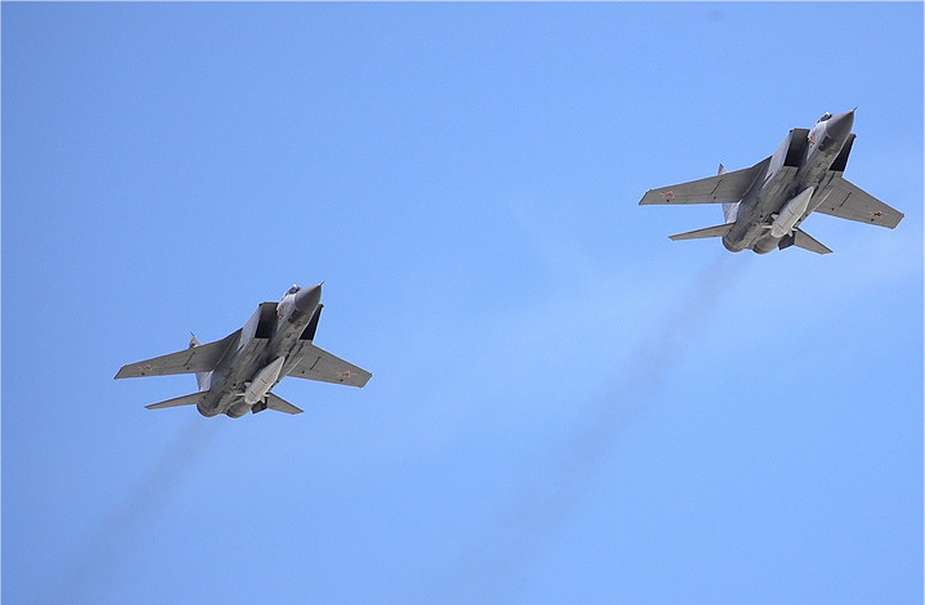Russia has ramped up the use of its Kinzhal hypersonic missile, as observed in recent Russian strikes in Ukraine where multiple Kinzhal missiles were deployed by Russian armed forces. A year ago, Russian President Vladimir Putin announced an increase in the production of this type of weaponry.
Follow Army Recognition on Google News at this link

MiG-31K fighter jets armed with Kinzhal hypersonic missiles (Picture source: TASS)
The Kinzhal is an advanced Russian airborne system equipped with hypersonic aeroballistic missiles. Its ability to fly at speeds greater than Mach 10 and reach targets over 1,500 kilometers makes it potentially impossible to intercept by air defense systems. However, Ukrainian forces have claimed multiple interceptions of this kind of missile.
Launched using Russian Air Force MiG-31K aircraft, and also tested on a Su-34 earlier this year, the Kinzhal has been in service since 2017 and represents a significant advancement in missile technology. It is developed by the Votkinsk Plant State Production Association and Tactical Missiles Corporation JSC.
The Kinzhal is a substantial missile, weighing about 4,300 kg and measuring an estimated 7.2 meters in length, with a diameter of about 1.2 meters, and a wingspan of 1.6 meters. It can carry a low-yield nuclear payload ranging between 5 and 50 kilotons, or a conventional high-explosive charge, powered by a solid-propellant rocket motor. Its operational range, including the distance covered by the carrying aircraft, is about 2,000 kilometers.
For guidance, the Kinzhal uses an Inertial Navigation System (INS) with mid-course updates for enhanced accuracy and is equipped with a steering system comprising four cropped delta fins.
The interception capability of current air defense systems against the Kh-47 Kinzhal is a complex issue that depends on the missile's unique characteristics and advancements in air defense technology.
The Kinzhal's primary feature, its hypersonic speed exceeding Mach 5, poses a significant challenge for current defense systems. This speed substantially shortens the response time for detection and engagement, requiring extremely fast reaction times from defense systems. The speed also impacts the tracking and targeting process, as most existing systems are calibrated for slower, more predictable targets.
Moreover, the missile's high maneuverability further complicates interception. The Kinzhal is designed to perform evasive maneuvers, making it difficult to accurately predict its flight path. This unpredictability demands advanced tracking and targeting capabilities that can adapt to rapid changes in trajectory.
Another factor to consider is the altitude at which the Kinzhal operates. Its ability to fly at various altitudes, sometimes within the upper atmosphere, poses an additional challenge for certain air defense systems optimized for lower altitude engagements.
Theoretically, there is no air defense system capable of intercepting Kinzhal missiles, yet the Ukrainians have claimed multiple times to have intercepted these hypersonic missiles. They have announced the interception of 10 out of 10 missiles fired by Russian forces. This interception might potentially have been carried out by Patriot systems, but as we have seen, such interception is theoretically not possible. Several explanations could be considered.
The first would be to suggest that one of the parties might have misrepresented the events, either Russia by overstating the capabilities of their hypersonic missile or Ukraine by announcing that all missiles were intercepted. Another possibility is that the Patriot air defense system's capabilities have been greatly underestimated. It is therefore challenging to distinguish truth from fiction, especially as neither party provides concrete proof to support their claims.
Currently, the development of systems capable of countering hypersonic threats is a focus for several countries. However, the effectiveness of these systems against a missile like the Kh-47 Kinzhal depends on various factors, including the specific capabilities of the intercepting system, the range, and the altitude of engagement. Despite progress, reliably intercepting hypersonic missiles remains a significant challenge with current technology.
Russia's significant increase in Kinzhal missile production, from one or two missiles per month to around ten missiles per month, was observed at the start of 2023, indicating an increased capacity to deploy these sophisticated weapons. Initially, Russia had a limited number of Kinzhals, with estimates indicating about 53 missiles at the start of the year. However, by early May, it was revealed that Russia had up to 80 Kinzhals, signaling an increase in missile production.
The increased production of Kinzhal missiles is primarily limited by the number of available MiG-31K aircraft for launching. These are specially adapted to be launch platforms for the Kinzhals. While Russia considered integrating the Kinzhal into other types of aircraft such as the Tu-160 or Tu-122M3, these plans have not yet materialized.
In February 2023, Russian President Vladimir Putin announced that Russia would continue the serial production of Kinzhal hypersonic systems, reflecting a desire to modernize and diversify its military arsenal.
Russia appears to have kept its promise, deploying these missiles in various operational contexts, especially in recent attacks on Kyiv. More than ten MiG-31 aircraft launched Kinzhal missiles at Kyiv, although Ukrainian air defense systems claimed to have shot down all launched Kinzhal missiles. Still, these claims could not be independently verified.
A pertinent question is how Russia has managed to increase the production of such advanced material. An article by The Insider, published on October 25, 2023, reveals that despite Western sanctions targeting most Russian defense production, the manufacturers of Kinzhal missiles have been able to circumvent European sanctions. This has allowed them to import the necessary equipment for production from different EU countries.
While the question of Ukraine's ability to intercept Kinzhal missiles remains unanswered, it is now clear that Russia has significantly increased the production of its hypersonic missiles.















